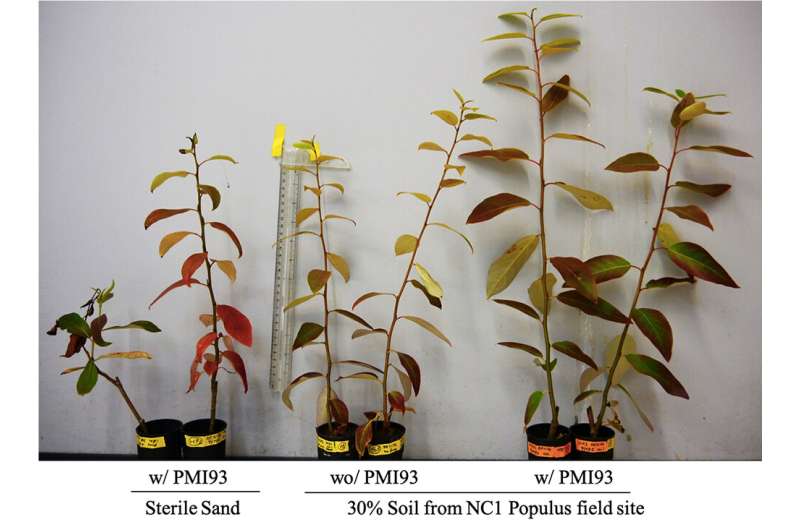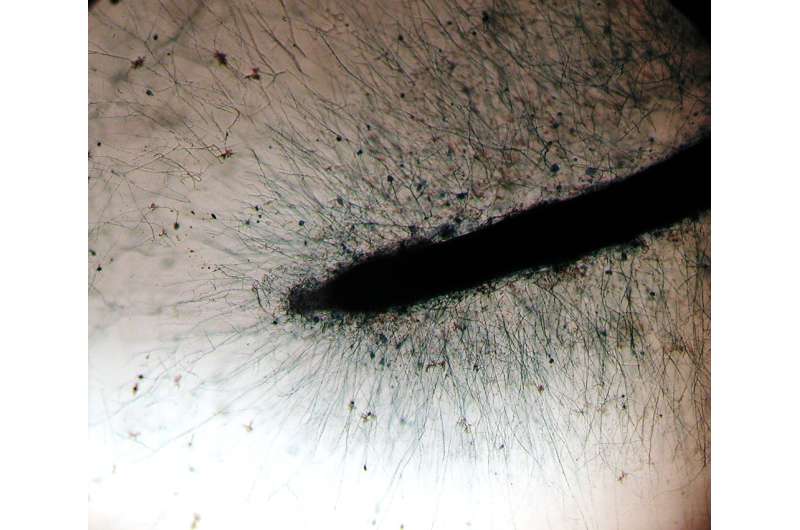Fungus fuels tree growth

The fungus Mortierella elongata enjoys a dual lifestyle; it can thrive in the soil as a saprophyte, living off decaying organic matter, or as an endophyte, living between a plant's root cells. The fungus is almost always found among and within poplar trees, and in an effort to understand its influence on the plant, a team of scientists studied what happens to the tree's physical traits and gene expression when the fungus is present.
Black cottonwood, or poplar, (Populus trichocarpa) is the fastest growing hardwood tree in the western United States, making it an energy feedstock of particular interest to the U.S. Department of Energy (DOE). By better understanding how poplar responds to its intimate associations with endophytes—a group whose effects on plants are still not well understood—scientists can better fine-tune their engineering efforts of both plants and root microbiomes to grow energy crops more efficiently.
To interrogate the close partnership of endophyte M. elongata and poplar, a team led by Hui-Ling (Sunny) Liao of the University of Florida collected forest samples of poplar and soil from Washington and Oregon. The cuttings included genotypes from the DOE BioEnergy Science Center (BESC), predecessor of DOE's Center for Bioenergy Innovation (CBI) at Oak Ridge National Laboratory. To see how the fungus affected poplar growth, the team compared poplar cuttings grown with and without an inoculation of the M. elongata strain PM193 added to a diluted soil mixture, publishing the results in Molecular Plant-Microbe Interactions.

The results were striking. Adding PM193 caused poplar cuttings to grow about 30 percent larger by dry weight than without PM193. By contrast, using a different endophytic fungus, Ilyonectria europaea, had no effect on growth. Liao's team partnered with the U.S. Department of Energy (DOE) Joint Genome Institute (JGI), a DOE Office of Science User Facility,, through its Community Science Program in order to get M. elongata and I. europaea genomes sequenced and annotated for this study.
The team found that, unlike pathogenic or mycorrhizal fungi (mutualist symbionts that induce structural changes in plant roots), M. elongata doesn't have as many gene products that directly influence plant phenotype, such as secreted proteins. However, M. elongata seems to encourage the plant to have leakier cell walls and weaker defenses in general; the fungus decreased the expression of poplar genes associated with plant defense (e.g. jasmonic acid and salicylic acid). The team also observed that the plants instead put more energy into growth, noting they increased expression of genes involved in signaling of gibberellin, one of the best-known plant growth hormones.
One other tidbit that caught the researchers' attention is that the poplar cuttings had increased expression of lipid signaling genes when they were inoculated with M. elongata. Poplar might be detecting lipids from M. elongata; the fungus produces them so prolifically it oozes. The team hypothesizes that lipids could act as a bridge of interkingdom communication between the plant and fungus.
Discovering how microbes can influence plant physiology helps scientists better understand how to optimize characteristics like growth rate. Harnessing that power could help usher widespread use of biofuel as a replacement to fossil fuel.
More information: Hui-Ling Liao et al. Fungal Endophytes of Populus trichocarpa Alter Host Phenotype, Gene Expression, and Rhizobiome Composition, Molecular Plant-Microbe Interactions (2019). DOI: 10.1094/MPMI-05-18-0133-R
Journal information: Molecular Plant-Microbe Interactions
Provided by DOE/Joint Genome Institute




















